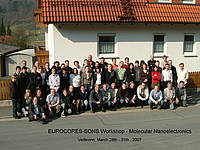Summary
Self Organised Nano-Structures (SONS) will be a rapidly growing field in the world of science in the next decade. Nanostructures are generated by self-assembly or self-organisation. These supramolecular hierarchical organisation processes are carried out by competing interactions between interlocking components. The nature and hierarchy of interactions determines the general view of the final nanostructured materials. It offers a great range of potential breakthroughs in many areas. For achieving the objectives global research programmes in nano-science accompanied with an interdisciplinary exchange are necessary. Therefore, the SONS I workshop in Veilbronn brought together the projects FUNSMARTs, NANOSYN and SASMEC of the EUROCORES-SONS program.
The workshop was hosted in Veilbronn. Veilbronn – a small village, 30 km in the east of Erlangen – is located in the region “Fränkische Schweiz” (Franconian Switzerland). This region was named by creative artists, who discovered the region in the 19th century and used the region for recreation and inspiration. There is hardly any other stretch of countryside that holds as many contrasts within such a small area: soaring towers atop rocky cliffs, winding valleys, blossoming orchards, mysterious and enchanting caves. This romantic landscape and the fact that the Franconain Switzerland is the region with the highest brewery density in the whole world stimulated a convenient atmosphere that fosters interdisciplinary exchange.
Description of the Scientific Scope and Content
During the 2.5 days workshop 25 excellent and stimulating lectures were given. Each half day session started with two topic lectures. Amongst many others Laurent Simon (FUNSMARTs), Nicolás Agrait (SASMEC), Heiko Weber (University of Erlangen) and Colin Lambert (University of Lancaster) gave lectures. An important asset of the workshop was the lectures, which were presented by students and young scientists. The talks were focussed on synthetic methodologies in chemistry, design and control of multifunctional molecular junctions and structure calculations of novel multifunctional electronic devices. The workshop also featured two poster sessions.
The workshop focused on fundamental aspects related to the chemical synthetic methodologies with chemistry / physics of nanostructured materials and structure calculations for the realization of novel multifunctional molecular electronic devices. Remarkably high impact came from the own scientific achievements that were presented in excellent lectures and illustrating posters. The success of the workshop was guaranteed by not only highlighting current state of the art but also by reviewing recent advances in the field.
The multidisciplinary background of the participants, the comfortable hosting in the hotel and a timetable, which contained ample time for discussions and tutorials until late night, provided a convenient framework for a fruitful workshop. The collaborations across “traditional” boundaries, that is, chemistry, physics, theory and engineering, were considerably strengthened. Furthermore, the workshop helped especially the young scientists to develop a “common” language to tackle interdisciplinary problems related to the mail thrust: molecule based nanoelectronics.


